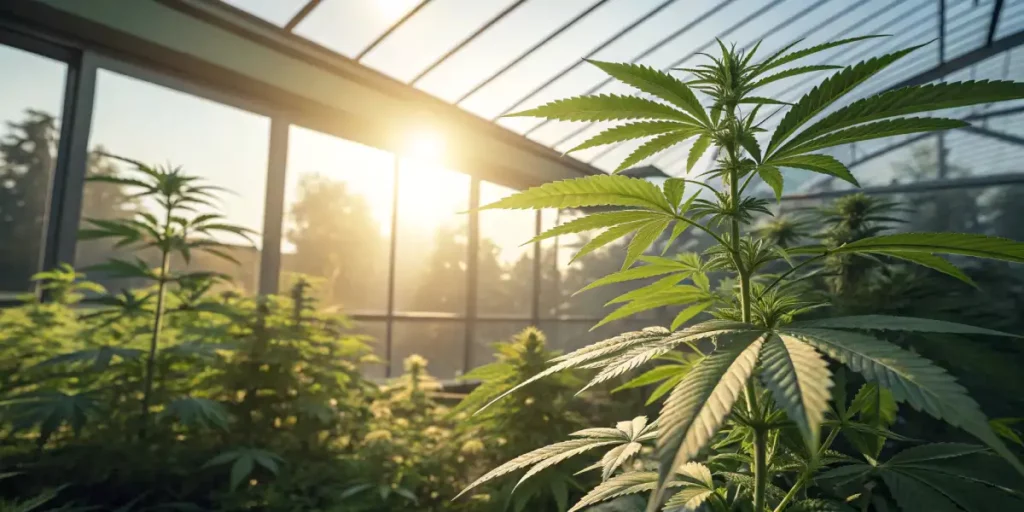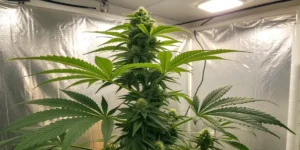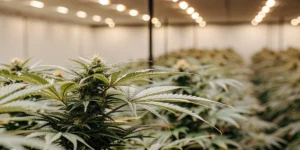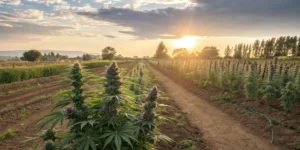When comparing greenhouse vs indoor weed, it’s essential to consider the specific conditions each environment provides. The weed debate centers on how natural sunlight in greenhouses contrasts with the full climate and lighting control of indoor setups. Greenhouses utilize sunlight while offering protection from the elements, whereas indoor systems rely entirely on artificial light and climate control, each offering distinct benefits.
When comparing different cannabis cultivation methods, it’s essential to consider the specific conditions each environment provides. Greenhouses utilize natural sunlight while offering protection from the elements. Indoor setups, on the other hand, rely entirely on artificial light and climate control, offering a different set of benefits.
Many growers find that greenhouse cultivation strikes a balance between the two. It allows for harnessing natural light and reducing energy costs while maintaining some control over the environment. Knowing these dynamics can help you decide which method aligns best with your goals.
Greenhouse vs Indoor Weed Yield Comparison
Yield is a critical factor when choosing your cultivation method. Greenhouses can produce substantial yields, thanks to the use of natural sunlight. This method often results in larger plants due to the expansive space and light availability.
Indoor setups, while typically producing slightly lower yields, provide more control over the growing conditions. This means you can maximize the efficiency of each plant. The choice between these methods often depends on your priorities and resources.
Greenhouse vs indoor weed yield comparison often highlights the potential for seasonal variations in greenhouses. During peak sunlight months, yields can significantly surpass those of indoor facilities. However, indoor growers benefit from year-round production cycles, unaffected by external weather changes. This consistency can offer a reliable supply chain for businesses.
Moreover, greenhouse vs indoor weed yield comparison also reveals differences in plant density. Indoors, growers can experiment with vertical farming techniques, potentially increasing yield per square foot. Greenhouse growers, conversely, might focus on maximizing horizontal space, allowing for larger plant growth and possibly more significant yields per plant.
Factors Influencing Yield
Several factors influence yield in both greenhouse and indoor environments. In a greenhouse, the quality of sunlight and the ability to manage temperature play significant roles. These factors can lead to higher yields compared to indoor setups, where light and temperature are artificially managed.
Indoor growers can optimize conditions, such as light cycles and humidity levels, leading to consistent yields. However, this requires a significant investment in equipment and energy. The strain of cannabis also plays a role. For instance, Northern Lights is known for its resilience in various environments.
When examining factors influencing yield, it’s essential to consider pest and disease management. Greenhouses provide some protection against pests, but they are not immune. Indoor environments, with their controlled settings, allow for stringent pest control measures, potentially reducing losses and improving overall yield.
Additionally, the choice of soil or hydroponic systems can significantly impact yield. Indoor growers often opt for hydroponics to maximize nutrient delivery and water efficiency. In contrast, greenhouse growers might lean towards organic soil methods, which can enhance natural terpene profiles and flavors, impacting the perceived quality of the yield.
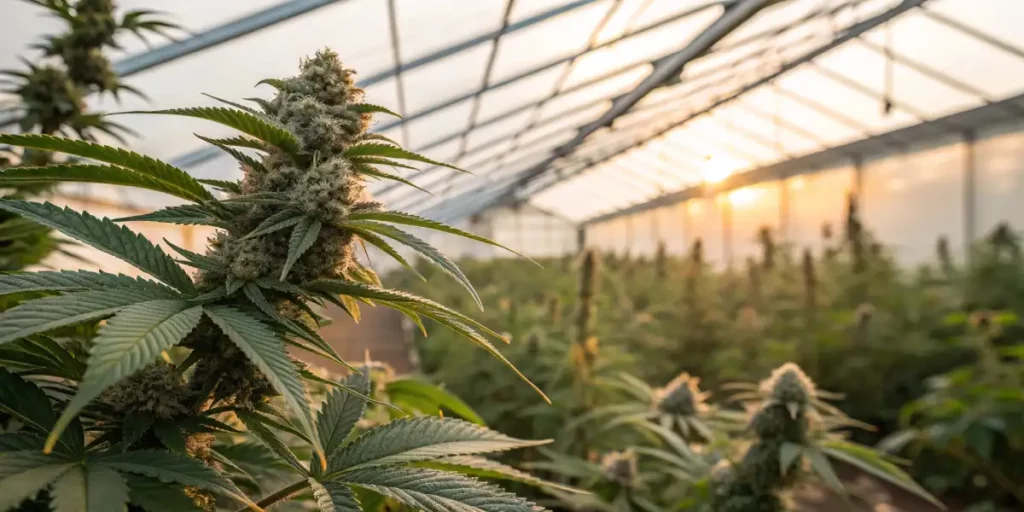
Advantages of Greenhouse vs Indoor Weed Cultivation
Greenhouses offer several advantages over indoor cultivation. They typically require less energy since they utilize natural light. This can lead to cost savings and a reduced environmental footprint.
In contrast, indoor cultivation provides unparalleled control over growing conditions. This makes it possible to produce high-quality cannabis consistently, regardless of external weather conditions.
One of the main advantages of greenhouse vs indoor weed cultivation is the potential for scalability. Greenhouses can be expanded more easily and cost-effectively than indoor facilities, which often require significant renovations to increase capacity. This scalability can be critical for growers looking to increase production without incurring prohibitive costs.
Another advantage of greenhouse cultivation is the potential for diverse crop rotations. Greenhouses can accommodate companion planting and other techniques that enhance soil health and pest resistance. Indoor systems, while highly controlled, may require more intensive soil or substrate management practices, adding to their complexity and cost.
Natural Light vs Artificial Light
One of the main advantages of greenhouses is the use of natural sunlight. This not only saves on electricity but also allows plants to grow in a more natural cycle. This can sometimes result in more robust plants.
Indoor setups rely solely on artificial lights, which can mimic the sun’s spectrum. This allows growers to control the photoperiod and intensity, leading to potentially higher-quality buds. Strains like White Widow thrive in such controlled environments.
With natural light, plants undergo natural diurnal cycles that can enhance their growth and development. This exposure can lead to more vibrant terpene profiles, contributing to the unique flavor and aroma of greenhouse-grown cannabis. In contrast, artificial lights, though energy-intensive, allow for precise control over the light spectrum, duration, and intensity, which can optimize photosynthesis and potentially increase potency.
The debate of natural light vs artificial light in cannabis cultivation often centers on cost and sustainability. While natural light is free, its availability can be unpredictable. Artificial lights guarantee consistent quality but at a higher operational cost. Balancing these factors is crucial for growers deciding between greenhouse and indoor setups.
Cost Differences in Greenhouse vs Indoor Weed Growing
Cost is a major consideration for any grower. The initial setup and ongoing expenses vary significantly between greenhouse and indoor cultivation. Greenhouses generally require a lower initial investment, especially if you already have a suitable structure in place.
Indoor cultivation, however, requires a greater upfront cost due to lighting, ventilation, and climate control systems. These systems also contribute to higher ongoing energy expenses.
When exploring cost differences in greenhouse vs indoor weed growing, one must consider long-term maintenance expenses. Greenhouses may require repairs due to weather exposure, while indoor setups might demand regular upkeep of advanced systems, such as HVAC and dehumidifiers, adding to operational costs.
Another consideration in the cost differences between cultivation methods is energy efficiency. Greenhouses benefit from natural light, significantly reducing electricity bills. Indoor growers can invest in energy-efficient technologies like LED lighting to mitigate energy costs, but the initial investment can be steep.
Balancing Costs and Returns
When evaluating cost, it’s important to consider both the initial investment and the long-term expenses. Greenhouses often offer lower ongoing costs, as they rely on free natural light. However, they may require additional investments in pest control and maintenance.
Indoor setups, while more expensive to run, can produce higher-quality cannabis that sells at a premium. This can offset the higher costs over time. Blue Dream is a popular strain that performs well indoors, potentially increasing profitability.
Balancing costs and returns is crucial when planning a cultivation strategy. Greenhouse growers might benefit from seasonal cost variations, with savings during sunny months offsetting higher pest management expenses. Indoor growers, however, often experience consistent costs, allowing for more predictable financial planning.
Moreover, the decision between greenhouse and indoor cultivation can be influenced by local regulations and market demand. Some markets may favor sustainably grown products, providing a premium for greenhouse-grown cannabis, while others may prioritize the consistent quality of indoor products, impacting the overall return on investment.
Greenhouse vs Indoor Weed Quality Differences
The quality of cannabis produced in greenhouses versus indoor setups can differ significantly. Greenhouse-grown weed often benefits from the full spectrum of natural sunlight, which can enhance certain plant characteristics.
Indoor-grown cannabis, however, can achieve exceptional quality thanks to the controlled environment. Growers can fine-tune conditions to produce premium buds with enhanced potency and flavor.
When considering greenhouse vs indoor weed quality differences, one should note the impact of environmental consistency. Indoor environments allow for year-round uniformity, ensuring each crop meets high-quality standards. Greenhouses, while benefiting from natural conditions, might experience quality fluctuations due to environmental changes.
Additionally, the approach to pest and disease management can influence the quality of the final product. Indoor environments, with their controlled settings, often use fewer pesticides, leading to cleaner, more organic products. Greenhouse growers may need to employ more robust pest strategies, impacting the purity and quality of their cannabis.
Environmental Control and Plant Quality
In a greenhouse, while there is some control over the environment, external factors like weather can still impact quality. However, the natural sunlight can enhance terpene profiles and overall plant health.
In contrast, indoor cultivation allows for precise environmental control, often resulting in superior quality. This is particularly beneficial for strains with specific needs, like Northern Lights, which can reach their full potential indoors.
Environmental control plays a critical role in plant quality, with indoor setups offering an edge in precision. Growers can adjust variables such as CO2 levels, humidity, and temperature to optimize conditions for specific strains, ensuring peak potency and flavor.
Conversely, greenhouse environments, while less controllable, offer plants a more natural growth cycle. This can enhance their resilience and overall health, resulting in robust, flavorful buds. The choice between these cultivation methods often reflects a grower’s priorities regarding quality and control.
Environmental Impact of Greenhouse vs Indoor Weed Production
Environmental considerations are increasingly important in the cannabis industry. Greenhouses generally have a lower environmental impact than indoor grows due to their reliance on natural light.
Indoor cultivation often involves significant energy use, contributing to a larger carbon footprint. However, advancements in technology and energy-efficient equipment are helping to mitigate these impacts.
The environmental impact of greenhouse vs indoor weed production is a significant concern for sustainable growers. Greenhouses, by leveraging natural sunlight, reduce dependency on electricity, decreasing their carbon footprint. This eco-friendly approach appeals to environmentally conscious consumers and can enhance a brand’s marketability.
On the other hand, the environmental impact of cannabis cultivation can be mitigated through innovative technologies. Indoor facilities are increasingly adopting solar panels and renewable energy sources to offset their energy consumption, demonstrating a commitment to sustainability despite their inherently higher resource demands.
Sustainable Practices and Their Benefits
Greenhouses can be a more sustainable choice, especially when combined with eco-friendly practices like rainwater collection and organic pest control. These methods reduce the overall environmental impact.
For indoor growers, investing in LED lighting and efficient HVAC systems can help reduce energy consumption. While the initial cost is higher, these investments can lead to long-term savings and a reduced carbon footprint.
Sustainable practices extend beyond energy use, encompassing water management and waste reduction. Greenhouses can implement rainwater harvesting systems, significantly reducing freshwater usage and enhancing their environmental credentials. Similarly, composting and natural pest deterrents can further minimize greenhouse impact.
Indoor growers, striving for sustainability, focus on recycling and repurposing materials, such as using biodegradable pots and organic nutrients. These practices not only reduce waste but also contribute to producing cleaner, more sustainable cannabis products, appealing to a growing segment of eco-conscious consumers.
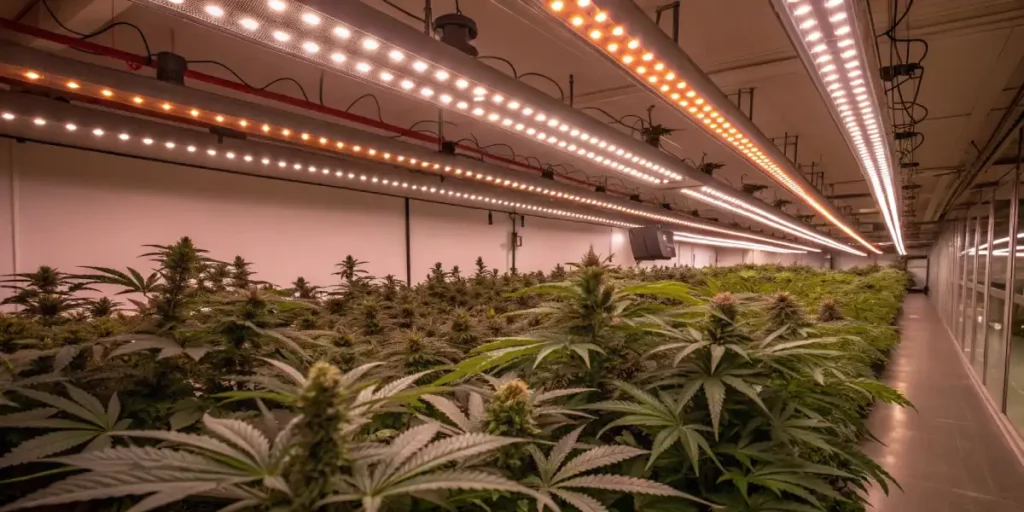
FAQs
What are the cost differences between greenhouse vs indoor weed growing?
Greenhouse cultivation typically involves lower initial and ongoing costs compared to indoor setups. This is primarily because greenhouses make use of natural sunlight, reducing the need for expensive lighting systems. Additionally, operational costs are generally lower as you rely less on artificial climate control.
Indoor setups, however, come with higher initial costs due to the need for advanced lighting, ventilation, and climate control systems. These add to ongoing expenses as they consume significant amounts of energy. Despite the higher costs, indoor systems allow for consistent quality and year-round production, which can offset the expenses.
When analyzing cost differences, it’s essential to consider the potential for government incentives or subsidies for sustainable practices. Greenhouse growers might benefit from tax breaks or grants aimed at reducing carbon footprints, further lowering their effective costs. Indoor growers could also leverage incentives for energy-efficient upgrades.
Additionally, the costs of labor and expertise can vary between greenhouse vs indoor weed growing. Indoor operations often require more technical knowledge to manage sophisticated systems, potentially increasing labor costs. Greenhouses, with their simpler setup, might allow for a more flexible workforce, impacting overall expenditure.
How does yield compare in greenhouse vs indoor weed environments?
Yields can be substantial in both environments, but they depend on several factors. Greenhouses can produce larger plants due to the abundance of natural light and space, often resulting in higher yields per plant. However, external conditions like weather can affect these yields.
Indoor environments, while typically yielding slightly less per plant, allow for multiple harvests per year due to controlled conditions. This can lead to comparable or even greater total yields over time. Your choice may depend on whether you prefer fewer, larger harvests or consistent smaller ones throughout the year.
In terms of yield, the variety of cannabis being cultivated can also play a significant role. Some strains are naturally more productive in greenhouse environments, benefiting from ample sunlight and space. Conversely, certain high-yield indoor strains have been bred specifically to thrive in controlled environments, maximizing output within limited spaces.
Furthermore, the choice of nutrients and growing medium significantly influences yield. Hydroponic systems in indoor setups can deliver nutrients more efficiently, potentially boosting growth rates and yield. Greenhouse growers might focus on organic soil amendments, enhancing plant health and yield through natural means.
What are the quality differences in greenhouse vs indoor weed?
Quality differences often stem from the control over growing conditions. Greenhouse-grown cannabis benefits from natural light, which can enhance certain qualities like terpene profiles. However, it may be subject to more environmental variability.
Indoor-grown cannabis generally achieves higher quality through precise control over all aspects of the growing environment. This allows for optimizing conditions for potency, flavor, and appearance. The choice between the two often depends on whether you prioritize natural growing conditions or precision and control.
Quality in greenhouse vs indoor weed can also be influenced by the drying and curing processes. Indoor facilities often have dedicated spaces for these critical steps, ensuring optimal conditions for preserving terpene profiles and potency. Greenhouse operations might rely more on natural airflow and sunlight, which could lead to variations in the final product.
The choice of strain also impacts quality. Some strains develop unique characteristics when grown under natural sunlight, while others may require the controlled conditions of indoor environments to reach their full potential. Knowing these nuances is key to achieving the desired quality in your cannabis products.
What are the environmental impacts of greenhouse vs indoor weed production?
Greenhouse production generally has a lower environmental impact due to reduced energy consumption. By using natural sunlight and incorporating sustainable practices, greenhouses can minimize their carbon footprint. This makes them an attractive option for eco-conscious growers.
Indoor growing, while more energy-intensive, can be made more sustainable through the use of energy-efficient technologies like LED lighting and advanced climate control systems. These can help mitigate the environmental impact, although they require a higher initial investment.
The environmental impact of greenhouse vs indoor weed production extends to waste management. Greenhouses can utilize compostable materials and recycle nutrients through organic farming practices, reducing landfill contributions. Indoor facilities might focus on minimizing waste through advanced recycling systems and sustainable packaging options.
Moreover, transportation and distribution can add to the environmental footprint. Greenhouse operations, often located in rural areas, may face higher transportation emissions. Indoor growers, typically closer to urban centers, might reduce these emissions but face other challenges related to urban infrastructure and logistics.
Are there specific strains that perform better in greenhouse vs indoor settings?
Some strains do better in specific environments. For example, Northern Lights and Blue Dream are often recommended for indoor growing due to their ability to thrive under controlled conditions. The indoor environment allows these strains to reach their full potential in terms of potency and flavor.
On the other hand, strains like White Widow can perform well in a greenhouse setting, benefiting from the natural light and larger growing space. Your choice of strain can be influenced by the specific conditions you can provide in your chosen growing environment.
When selecting strains for greenhouse vs indoor weed cultivation, consider the plant’s growth characteristics. Sativa-dominant strains often thrive outdoors or in greenhouses, where they can fully extend their branches. Indica strains, with their compact growth, may be better suited for indoor environments where space is limited.
Additionally, consider the climate of your growing location. Strains that are naturally resistant to humidity and temperature fluctuations might excel in greenhouses, while those requiring stable temperatures and low humidity could perform better indoors. Knowing these traits can guide your selection for optimal growth and yield.

